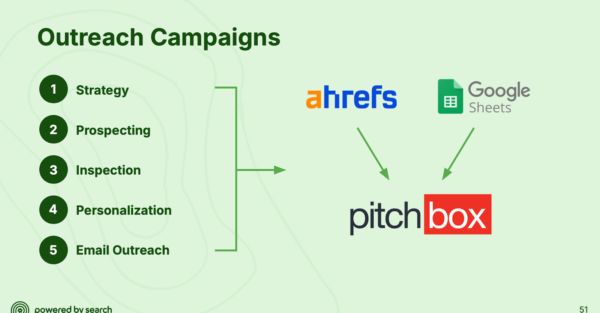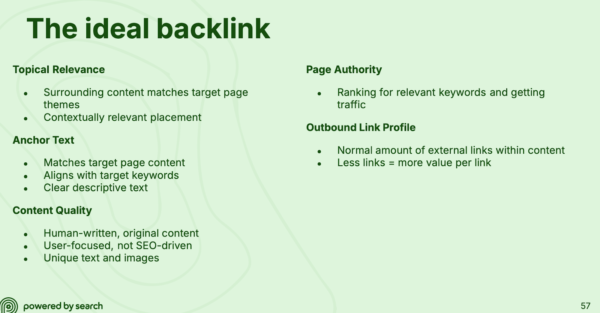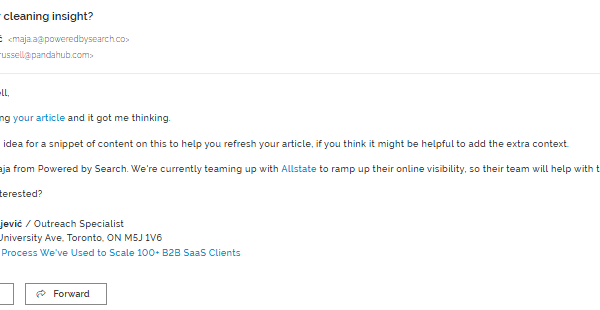How To Execute SaaS Blogger Outreach Campaigns In 2025
Last updated: February 11th, 2025
There are two primary reasons a blogger outreach campaign may fail:
- Recipients never respond to the outreach email.
- The outreach email was successful and the link was placed, but the SaaS company’s SEO never improved (e.g., rankings, authority, and traffic, etc., didn’t increase).
However, if you do a quick Google search for any competitive keyword, you’ll see that the top ranking posts probably have plenty of links. Links are still essential to rank in search results.
So, how do you consistently earn links that meaningfully impact your SEO?
In this post, we’ll explain the most common mistakes that cause blogger outreach campaigns to fail for B2B SaaS companies and the step-by-step process we use to earn meaningful links consistently.
Do I Need To Do Blogger Outreach (Can’t I Earn Links Organically)?
This is a valid question to address before we discuss our blogger outreach strategy.
There’s a school of thought that you don’t need to build links because you can earn them organically as long as you produce high quality content. And there’s certainly some truth to this. Writers often naturally link to pages to support their claims.
The problem is that most writers find content to support their claims (and therefore link to) by Googling the topic. Then, they select a blog post on the first page of Google that supports their claim and link to it.
Unfortunately, if you aren’t already on the first page of Google, it’s unlikely that journalists and bloggers will find your page to link to it.
This means you need to build a few high quality links manually to propel the page to the first page of Google so that it can start earning links organically.
Why Most Blogger Outreach Campaigns Fail
You already know that sending thousands of cold emails isn’t an effective method to earn meaningful links. Instead, these are the four most common (and less obvious) reasons blogger outreach campaigns often fail.
Reaching Out To Irrelevant Websites
Domain authority is often the primary metric used to evaluate potential link partners, though we’ve found SaaS companies receive a much better long-term ROI by prioritizing topical relevance (e.g., target smaller yet authoritative websites directly related to your niche).
First, editors for large websites with high domain authority, like news websites, typically receive hundreds of pitches daily, making it difficult to cut through the noise and receive a response.
Unless you have data or a story that’s truly groundbreaking and newsworthy, there isn’t really an incentive for them to respond to you.
Instead, reach out to a smaller website directly related to your niche. These journalists and bloggers are much more likely to respond because they receive fewer pitches, and your new data, statistics, and opinions on relevant, trending industry topics are likely more helpful to them.
Backlinks from these websites are often more meaningful than links from large new websites because links from niche websites show search engines you’re an authority in that niche.
Contacting The Wrong Person
If you contact anyone other than the person who has the power to change the link, you’re less likely to earn the link. Chances are, the recipient isn’t going to forward your email to a colleague.
The best person to contact is usually either the editor or writer.
Outreach Messages That Provide Little Value To Recipients
Another reason your blogger outreach campaign may fail is that the value you’re offering isn’t compelling.
For example, most pitches sound like this:
“You should swap the existing link to our blog post, because we have a more up-to-date guide.”
Your blog post might be better, but the work involved for an editor to change the link far outweighs the benefit of offering readers a link to a slightly better article.
For most editors, the work created by changing the link is often greater than the value it would add to their content. This is particularly true for larger blogs that receive hundreds of link requests per week. In fact, it would likely take them several hours each week to execute every link request.
Instead, think about your recipient’s calendar. Does the value of swapping the link warrant 15 minutes of their time that could be dedicated to other high value tasks?
Earning an Insufficient Number of Links
Finally, if you’re among the rare percentage of SaaS marketers who have earned a handful of links from high-quality, niche websites but have still not seen an ROI, the problem may be link volume.
It’s important to prioritize link quality over volume, but a page with equal quality content and more high quality links will likely still outrank you. Sometimes the problem is that you haven’t built enough high quality links.
Step By Step Blogger Outreach Process That Generates Meaningful Results
This is our proven, step-by-step blogger outreach process to help you increase outreach response rates and build relationships (and links) that meaningfully impact SEO.

Step 1: Strategy
Most blogger outreach strategies fail because the effort of swapping the link outweighs the value doing so delivers for the recipient.
To increase response rates, you need to both:
- Reduce the work for the recipient
- Increase the value for the recipient
The solution is to identify specific pages where it makes sense to link to our post (rather than asking them to find a page on their website to link to us) and explain the value of linking to our post.
Therefore, we first ask these questions to identify specific blog posts where a link partnership might make sense:
- What kind of page would link to my page? What topic?
- Why would they link to my page? (more in-depth, up-to-date, unique perspective).
Step 2: Prospecting
If you’ve tried blogger outreach in the past and earned links but didn’t see a strong ROI from those links, the problem is likely that the linking websites weren’t relevant to your niche or they lacked credibility.
Search engines use links to understand a website’s area of expertise and general credibility.
The more links your website has from other credible websites in your niche, the better you’ll likely rank for industry-related keywords.
While most link builders use domain authority as the primary metric to evaluate potential link partners, this metric isn’t a complete analysis of a website’s credibility (and domain authority is a third party metric created by SEO tools, which some website owners have figured out how to fake).
Instead, these are additional factors that impact the degree of authority a link will pass to your website:
- The topical relevance of the website/page: A link from a cybersecurity blog indicates to Google that you’re an authority on cybersecurity, whereas a link from a generic news website doesn’t clearly indicate the topic you’re an authority)
- The authority of the linking page: A page with 10 other high quality domains linking to it will be more valuable than another page on the same website that doesn’t have any links.
- The page and domain traffic: Ideally, it’s best to earn links from pages that already have traffic from your target audience as you’ll not only earn the benefit of the link, but also potentially earn new prospects to your website through that link.
- Keywords and rankings for the page: If the page is ranking for some valuable keywords our target audience might search, a link from that page will be far more valuable.
Here are the specific metrics we filter for to ensure each link we earn for clients checks all of the boxes mentioned above:
- DR20+
- Domain traffic of 5000+
- Page traffic 1+
- Specific keywords the page is ranking for
Step 3: Inspection
Metrics are excellent for creating an initial list of link prospects, but you’ll find that some of the prospects on that list aren’t necessarily good candidates.
For example, there aren’t really tools to filter out inactive websites, and it’s best to personally check the quality of the content.
Therefore, we manually review each potential prospect using this checklist:
- Is it a legit website/company? Some websites exist solely for link building, and their links offer little to no value to your website. We only want to build partnerships with credible websites with industry authority.
- Is it active? We don’t need links from inactive blogs.
- Is the content high quality? If it looks like the content is written by AI and doesn’t provide any insightful ideas, it might not be a blog we want our client’s brand associated with.
- Can we get a link above the fold? A link at the bottom of the page is less powerful than one at the top, so we aim to position all of our links above the fold.

Step 4: Personalization
If the person you contact doesn’t have access or authority to change the link, your request will likely be ignored as they won’t want to take the time and effort to involve other team members to review your request and accept or deny it.
This is why we invest a lot of time and effort into finding the best possible point of contact.
We look for these people (in this order) when crafting outreach campaigns:
- Writer
- Editor
- Marketing
- Owner (for solo blogs)
Once we find the right person to contact, we also consider the best medium to use to contact them. We typically use email, but if they have a substantial social media presence, we may also contact them on social media.
Step 5: Email Outreach
A mistake many people make is only personalizing the email with the recipient’s name. However, this is table stakes. A personalized message shows that you’ve actually read their work and explains the value your link can add to that specific post.
This level of detailed personalization is difficult to scale, so we create custom templates for each segment/sub-topic.
For example, here’s an example of a custom template we created targeting link prospects that have a blog post on vehicle maintenance and driving safety.

This message works because it provides value by offering to refresh their content for free.
When it makes sense, we also like to inject humor. Most recipients receive hundreds of generic email pitches, and this can make yours feel like it’s coming from a real human.
You’ll also notice that we avoid using fake flattery. For example, many bloggers receive emails that say “we loved your blog post on X!” However, this flattery can feel hollow if you don’t explain what you liked about it or how it has impacted you.
Finally, we also always follow up at least twice. Many of these people are quite busy, and they may have simply missed your email or have forgotten to respond, so following up can significantly increase your response rates.
Does Blogger Outreach Still Work?
Yes, blogger outreach still works, but the dated tactics used several years ago do not. Review your own blogger outreach strategy.
Does it check all the boxes outlined in our step by step process above? If your strategy isn’t producing sufficient results, you probably need to tweak some of the steps in your strategy.
We’ve found that many link building services use a similar approach, but they miss some of the finer points within each step of the strategy.
For example, they may exclusively use domain authority and topical relevancy to determine potential link partners rather than the full criteria we use that also considers traffic, page authority, keyword rankings and involves a manual review of content quality and consistency.
Get More Help With Your Blogger Outreach Strategy
This step by step strategy is exactly how we get results for clients, but the real key to success is accurately executing the finer details of the strategy.
If you’re still struggling with blogger outreach, reach out to our team today, and we will audit your strategy.
We can identify why it isn’t working, how to fix it, and map out a long-term plan to improve your link building ROI.
What you should do now
Whenever you’re ready…here are 4 ways we can help you grow your B2B software or technology business:
- Claim your Free Marketing Plan. If you’d like to work with us to turn your website into your best demo and trial acquisition platform, claim your FREE Marketing Plan. One of our growth experts will understand your current demand generation situation, and then suggest practical digital marketing strategies to hit your pipeline targets with certainty and predictability.
- If you’d like to learn the exact demand strategies we use for free, go to our blog or visit our resources section, where you can download guides, calculators, and templates we use for our most successful clients.
- If you’d like to work with other experts on our team or learn why we have off the charts team member satisfaction score, then see our Careers page.
- If you know another marketer who’d enjoy reading this page, share it with them via email, Linkedin, Twitter, or Facebook.